L. Q. C. Lamar is perhaps Mississippi’s most noted nineteenth century statesman. He was the first person, and one of only two in American history (the other was South Carolina’s James Byrnes in the twentieth century), to serve in the U.S. House of Representatives, the U. S. Senate, as a member of the President’s Cabinet, and as a justice on the U. S. Supreme Court. Despite these accomplishments, Lamar's legacy is tainted today by his active role in the reestablishment of White supremacy in the post-Reconstruction South.
Lamar is one of only eight leaders featured in John F. Kennedy’s Pulitzer Prize-winning book, Profiles in Courage. He is included there along with men such as John Quincy Adams and Daniel Webster.
Reconciling North and South
L. Q. C. Lamar is cited by Kennedy for his courage in healing the wounds between North and South, which had been festering since the end of the American Civil War in 1865. In 1874, Lamar was a newly elected congressman from Mississippi, and the first former Confederate official from the state allowed back in the U. S. House of Representatives. He shocked the nation by delivering a moving eulogy after the death of Charles Sumner, a U. S. senator from Massachusetts who was known as one of the South’s greatest enemies.
Senator Sumner, a major figure in the fight for the abolition of slavery, had been beaten severely with a cane on the floor of the Senate by a congressman from South Carolina prior to the Civil War. After the war, Sumner played a leading role in forming the Reconstruction policies that affected Mississippi.
The U. S. House of Representatives was packed when L. Q. C. Lamar, a Civil War veteran from Mississippi and one of the so-called “rabid fire-eaters” before the war, spoke about the need for unity between North and South in the name of the departed Sumner. Grown men were reduced to tears by the speech.
Lamar closed his speech with this sentence: “My countrymen! Know one another, and you will love one another.” Few speeches in American history have had such an immediate impact, according to John F. Kennedy. Lamar immediately became one of the most respected leaders in Congress and throughout the country, and his speech marked a turning point in relations between North and South. Read that speech at http://www.bartleby.com/268/10/6.html.
Lamar later admitted that this famous oration was nothing more than "a political necessity, to give the South a hearing in the North."
Pre-Civil War years
Lucius Quintus Cincinnatus Lamar was born in Georgia in 1825. His father was a lawyer, but committed suicide when Lucius was only nine years old. The man who became like a father to Lamar was Judge Augustus Baldwin Longstreet, who was a cousin of James Longstreet, one of General Robert E. Lee’s commanders in the Civil War. Judge Longstreet was the president of Emory College near Atlanta. Lamar became a lawyer and married Longstreet’s daughter, Virginia. When Judge Longstreet became president of the University of Mississippi, he hired his new son-in-law as a mathematics professor. Lamar moved to Oxford, Mississippi, in 1849 where he also practiced law. In 1857, at the age of 32, Lamar won his first race for Congress. A contemporary described him as “gifted with eloquence and of scholarly attainments, with no political or moral sins to answer for.”
In a letter to a friend, Lamar wrote that he longed for a leader capable of “rising above the passions and prejudices of the times who would speak to both sections in a spirit at once tolerant, just, generous, humane, and national.” Little did he realize that he was foreshadowing his own unifying speech twenty years later.
White Mississippians loved Lamar for his courtly Southern manners, his intelligence, and his devotion to duty. Congressman Lamar and Senator Jefferson Davis were the state’s most popular political leaders at the beginning of the Civil War.
Author of secession; Confederate diplomat
Like most Southern politicians of his time, Lamar was a firm supporter of states’ rights and slavery. Convinced that the South’s position was proper and constitutional, he resigned from Congress in January 1861 and returned to Mississippi where he wrote the official Mississippi Ordinance of Secession, which stated, "Our position is thoroughly identified with the institution of slavery - the greatest material interest of the world." He served as lieutenant colonel of the 19th Mississippi Regiment and was cited three times for bravery and outstanding leadership.
Jefferson Davis, who served as president of the Confederate States of America, appointed Lamar in 1862 as Confederate minister to Russia and special envoy to England and France. He never made it to Russia, but his charm, his manners, and his skill as a speaker made him a hit in London. Lamar spent the rest of the war in diplomatic service to the Confederacy.
The war was costly for the Lamar family, as it was for most. Both of his brothers were killed in battle, as well as his two law partners.
National politician
During the first years of Reconstruction, Lamar believed, along with General Lee, that former Confederate leaders should stay out of the limelight. Despite a ban on former Confederate officers holding federal office, in 1872 he ran for and won a seat from Mississippi in the U. S. Congress. In the words of historian John K. Bettersworth, “Lamar’s intellectual brilliance, his power as a speaker, his gentlemanly conduct to friend and foe alike, won him not only the normal Democratic vote but considerable Republican support as well.” Congress passed a special bill in December 1872 permitting him to take his seat in 1873, making Lamar the first Democrat in the U. S. House of Representatives from Mississippi since the end of the Civil War.
It was about a year later when Lamar delivered his memorable eulogy of Charles Sumner in which he called for an end to the bitterness between North and South. His intention was to promote national harmony and to hasten the end of Reconstruction in the South. He became so popular nationally that he traveled around the country on a speaking tour.
Lamar's national prominence obscured the active role he played in dismantling Reconstruction in Mississippi to the detriment of the state's African American citizens. In 1875, during Mississippi’s statewide elections, Lamar planned a strategy which defeated the Radical Republicans and returned power to the Democrats. This strategy by White Democrats included violence and economic pressure to intimidate Black voters who supported the Republicans as the party of Lincoln. However, Lamar accepted the new Constitutional amendments granting rights to African Americans and asked his constituents to do likewise. Those amendments were the 13th Amendment which outlawed slavery, the 14th Amendment which granted African Americans the same rights as White citizens, and the 15th Amendment which allowed African American men to vote. Lamar opposed setting up the Democrats as a White man’s party and campaigned openly and successfully for votes from Black citizens.
In 1876, the Democratic state legislature elected Lamar to the United States Senate. No former high-ranking Confederate had yet become a senator. Georgia’s Alexander Stephens, who had been vice president of the Confederate States of America, had earlier been denied his seat. Lamar had strong support in Mississippi and in Washington, from Black people as well as White people, Republicans as well as Democrats. In 1877, he became the first former Confederate leader in the U. S. Senate.
Compromise of 1877
Lamar’s talent for reconciliation and compromise played a pivotal role in the controversial presidential election of 1876. The Democrat, Samuel Tilden, lost to Republican Rutherford B. Hayes despite having more popular votes and seemingly more votes in the Electoral College. Since African American voters had been disenfranchised, Mississippi voted overwhelmingly for the Democrat Tilden. To resolve the dispute, Congressman Lamar, who would soon be Senator Lamar, helped set up a nonpartisan Election Commission, which chose Hayes as president.
Behind the scenes, Lamar was very involved in the bargaining and won many concessions for the South in exchange for supporting the Commission’s conclusions. Many Southerners were outraged that the election had in their eyes been stolen from the Democrat Tilden. They were more outraged that Lamar was involved in the deal. He faced a storm of opposition because most White voters in Mississippi thought that a Hayes election would mean four more years of federal oversight. In hindsight, Lamar’s negotiating helped bring an end to Reconstruction under President Hayes’s administration and hastened the end of African American political rights in Mississippi.
Free silver
Lamar’s next challenge came when the Mississippi State Legislature passed resolutions asking Senator Lamar to support “free silver.” The free silver movement advocated unlimited coinage of silver. Since this inflationary policy would help farmers by raising the price of their crops and help debtors pay their debts more easily, it was popular in an agrarian state like Mississippi where many citizens still had high debts from the Civil War and Reconstruction. But the scholarly Lamar had studied the issue, and he believed that free silver was bad economic policy.
When the time came to vote, Senator Lamar gave a dramatic speech about how difficult it was to go against the wishes of his constituents. Yet his conscience demanded that he vote against free silver. His colleagues in the Senate congratulated him for his courage to stick to his principles.
Back in Mississippi, the reaction was swift and bitter. Mississippians felt Lamar had turned his back on Mississippi and the South. They felt betrayed. Even Jefferson Davis publicly condemned Lamar’s actions. Most political observers agreed Lamar’s political career was over.
The criticism hurt Lamar deeply. He decided to go on a statewide speaking tour and explain his vote directly to the people. He spoke to thousands of people in large meetings, indoors and outdoors, all around the state. It was a time before television, radio, and movies, a time when political speaking was a form of entertainment and drew large crowds. Lamar was one of the best speakers in the country and used his skills to explain his position.
In his book, Profiles in Courage, John F. Kennedy relates the following about Lamar’s stump speech.
“At each meeting Lamar told of an incident which he swore had occurred during the war. Lamar and other high ranking Confederates were on board a blockade runner in Savannah harbor. Although the high ranking officers had decided it was safe to go ahead, the Captain had sent sailor Billy Summers to the top mast to look for Yankee gunboats in the harbor, and Billy said he had seen ten. The distinguished officers said that was impossible because the Yankee fleet wasn’t in Savannah. They said to go ahead. The Captain refused, insisting that while these officers knew a great deal more about military affairs, Billy Summers on the top mast with a telescope had a better opportunity to judge the immediate situation at hand.
Turned out that Billy was right and he kept them all from being captured. Lamar said that like Billy Summers, he did not pretend to be wiser than the Mississippi Legislature. But he did believe that he was in a better position as a member of the United States Senate to judge what was best for his constituents.”
His speaking tour persuaded White Mississippians that Lamar did what he thought was right. The people of Mississippi continued their support for him, in spite of the fact that on three important occasions — the eulogy of Charles Sumner, the controversial election of President Hayes in 1876, and his strong stance against free silver — Lamar had stood against their immediate wishes.
Lamar was a strong supporter of federal aid to public education. His support was based primarily upon the aid it could give the White population, but Lamar observed “this bill is a decided step toward the solution of the problem of race.” By advocating education as a solution to the "problem of race", Lamar was again a man ahead of his time.
Cabinet member; Supreme Court justice
President Grover Cleveland appointed Lamar Secretary of the Interior in 1885. Two years later, Cleveland nominated Lamar for the United States Supreme Court. He was approved by the Senate in January 1888 at the age of 63, becoming the first ex-Confederate to serve on the nation’s highest tribunal and served there until his death.
In January 1893 Lamar died of a heart attack while visiting family in Georgia. He was buried in Macon, Georgia, but his body was later moved to Oxford, Mississippi. He was buried with a copy of the U.S. Constitution in his right hand — the same copy he had carried with him for many years.
Kennedy called Lamar “the most gifted statesman given by the South to the nation from the close of the Civil War to the turn of the century.” Lamar’s life illustrates public service leadership. He loved his state, loved his country, and did his best to reconcile the differences between North and South. However, his advancing the cause of white supremacy and upending the gains of African Americans will forever mar his reputation.
William “Brother” Rogers is assistant director for programs at the John C. Stennis Center for Public Service in Starkville, Mississippi.
-
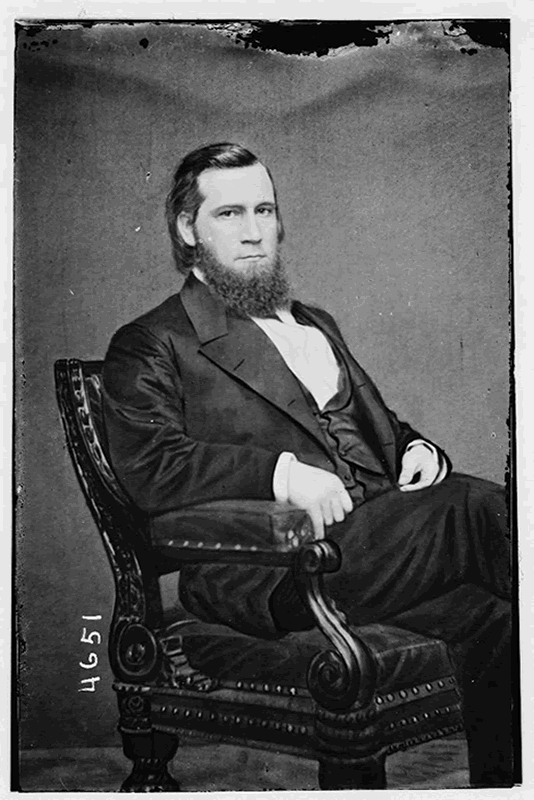
L.Q.C. Lamar photograph created between 1855 and 1865, possibly while he was a U.S. Congressman. Photograph courtesy Library of Congress Prints and Photographs Division, call number: LC-BH82-4651B -
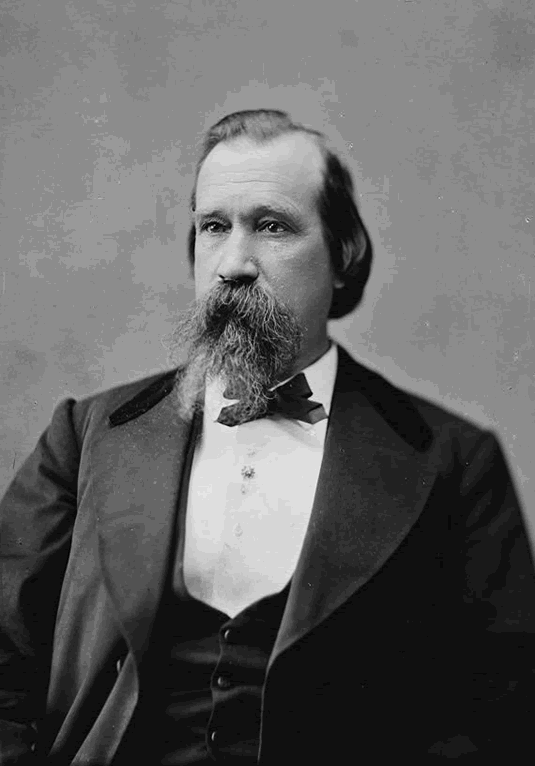
Lamar photograph created between 1870 and 1880, possibly while he was a U.S. Senator. Photograph courtesy Library of Congress Prints and Photographs Division, call number: LC-BH826-28955
-
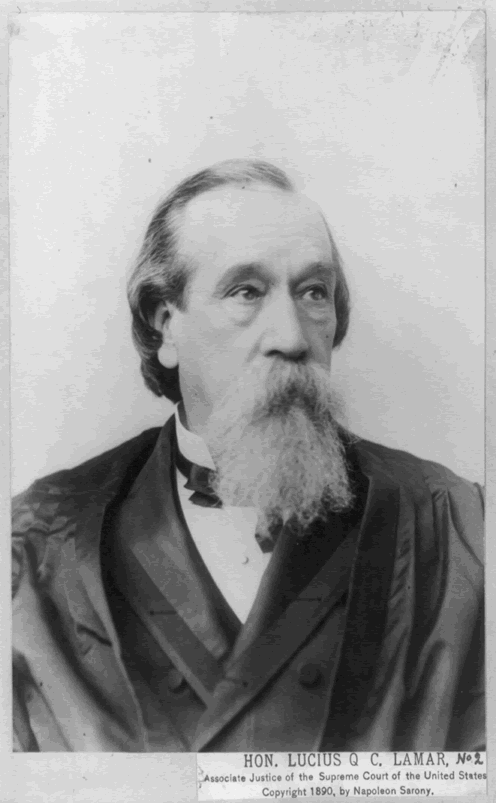
The Honorable L.Q.C. Lamar. Photograph created circa 1890 during the time he served on the U.S. Supreme Court. Photograph courtesy Library of Congress Prints and Photographs Division, call number: LC-USZ62-56553 -
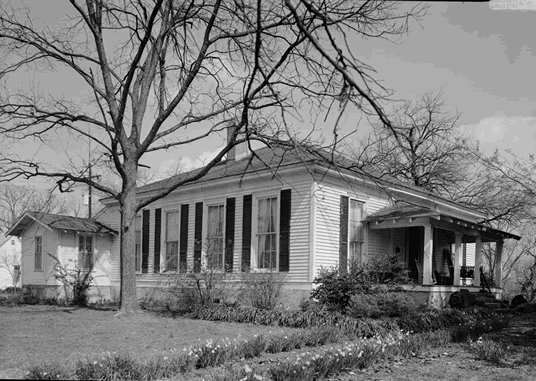
The L.Q.C. Lamar house at 616 North 14th Street in Oxford, Mississippi. A 1975 photograph from the Historic American Buildings Survey (Library of Congress). The Oxford-Lafayette County Heritage Foundation purchased the house in 2003 and has undertaken the restoration of the house. Photograph courtesy Library of Congress Prints and Photographs Division, call number: HABS MISS, 36-OXO,7- -
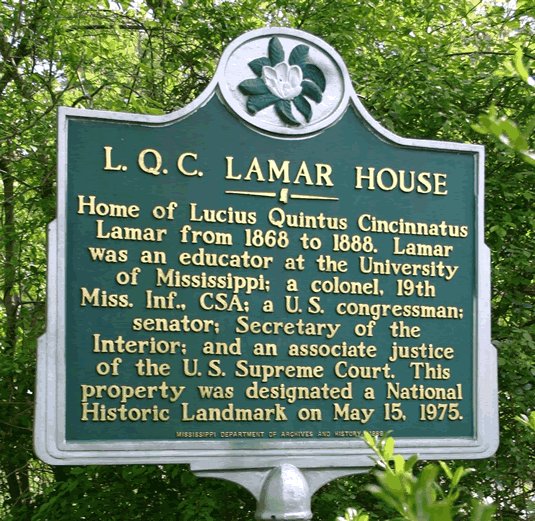
Marker erected by the Mississippi Department of Archives and History in 1989 at the Lamar House in Oxford.
Sources:
Biographical Directory of the United States Congress, http:// bioguide.congress.gov/ scripts/biodisplay.pl?index=L000030
Burger, Nash K. and John K. Bettersworth. “L.Q.C. Lamar: Artificer of Reconciliation.” In Mississippi Heroes, edited by Dean Faulkner Wells and Hunter Cole, pp. 107-142. Jackson: University Press of Mississippi, 1980.
Kennedy, John F. Profiles in Courage. New York: Harper and Row, 1956. http://www.senate.gov/reference/reference
_item/Profiles_In_Courage.htm
